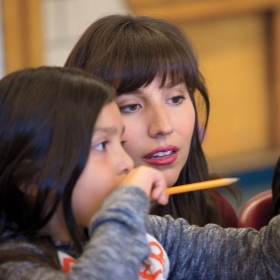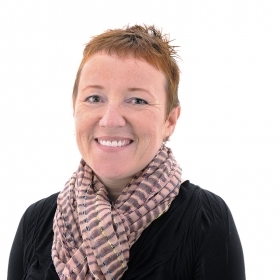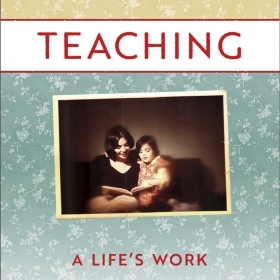Early childhood educators are adjusting to the pandemic with grit, imagination, and love—hoping it won’t be a lost year after all.
Wellesley has a long tradition of sending its graduates into the classroom. How, we wondered, are these professionals meeting the demands of the pandemic? This winter, we sought out seven Wellesley early childhood and elementary school educators to find out.
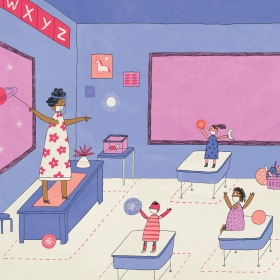
You don’t have to look far for alarming news about the state of children’s education during the COVID-19 pandemic. A study released in Britain and widely tweeted in the United States reported that young British children kept out of preschool were forgetting how to use knives and forks. A December 2020 Atlantic article reported on a study suggesting that students will experience about seven months of “learning loss” as a result of pandemic accommodations, with Latino and Black learners suffering even more. In April 2020, two weeks after schools closed so unexpectedly, U.S. News & World Report cited federal Department of Education data showing that 14 percent of children ages 3 to 18—about 9.4 million students—were without internet access at home. Other estimates suggest that number is much higher.
Teachers worry about lost opportunities and injustices—about connectivity, about unequal access to resources, about food insecurity, about social and emotional growth, about whether kids are falling behind. But they’re also preoccupied with more immediate issues: Will my pre-K science students keep their masks on? Will my fourth graders ever learn to mute themselves on Zoom? Are there enough hours in the day to get my online, in-person, and asynchronous prep work done in time?
Wellesley has a long tradition of sending its graduates into the classroom. How, we wondered, are these professionals meeting the demands of the pandemic? We sought out seven Wellesley early childhood and elementary school educators to find out. Some teach in public school settings, others in private independent schools. Some work in poor areas hit particularly viciously by the virus, others teach in more affluent communities. Some are veterans, some are fairly new to the work. Some are in physically distanced classrooms, others are trying to teach outdoors as long as they can, while others are hybrid or fully remote. All have been working 12 to 15 hour days, routinely. And all have been inspired by the resilience, humor, and willingness to follow pandemic protocols shown by their young charges.
Growing Up Online
Lisa Koplik ’13 teaches fourth grade in a Wakefield, Mass., public school. It’s her seventh year in the district. This year, her class is 100 percent online, taught from a well-organized desk in her apartment.
“Anyone in the district who chose to be fully remote in fourth grade is in my class,” she says. “We are called the Remote School.”
Koplik teaches two cohorts per day for two hours and 50 minutes each, all days except Wednesdays. On those days, she spends an hour with each cohort and then does curriculum planning.
“Normally I have about 20 to 24 kids, and almost 100 percent of them live in Wakefield and are middle to middle-upper class,” she says. But this year, her 31-student group includes students from the METCO program in Boston, a voluntary school-integration program that enrolls Boston students in participating suburban public schools.
“I have so much more diversity, and I am absolutely loving it,” Koplik says. “I was a little bit nervous about it at first, because—after everything that happened this summer and everything that’s going on in the world—I just wanted to do as good a job as I could to support these children. I’m trying to make sure that all these kids have their materials, that it’s equitable, that their computers are working, that they have the tools they need. I think we’re finally at a point where I can hear everybody. They can see me. I can see them. They have their math books. Everything has been pretty much resolved.”
Koplik has adapted well to remote teaching, she says. “I’ve finally gotten to the point where this is my jam. I’m all about it.”
She feels fortunate to be working with fourth graders. “They are at a point in their development where they can handle the demands that remote learning requires,” she says. She teaches reading, writing, and math, and her students see specialists for other subjects.
Living through the pandemic has definitely changed the children, Koplik says. “Corona has really impacted their ability to see the big picture in ways I’ve never had fourth graders articulate before,” she says.
In November, Thanksgiving month, she ran a couple of morning meetings to ask her students about things they were grateful for. “The level of response that I get from kids this year, it’s so deep, so beyond anything I’ve ever had kids say in the past. They just get it,” she says. “I had a kid that said, ‘I’m grateful that we can be remote so my family can be safe.’ They definitely have a broader understanding of reality.”
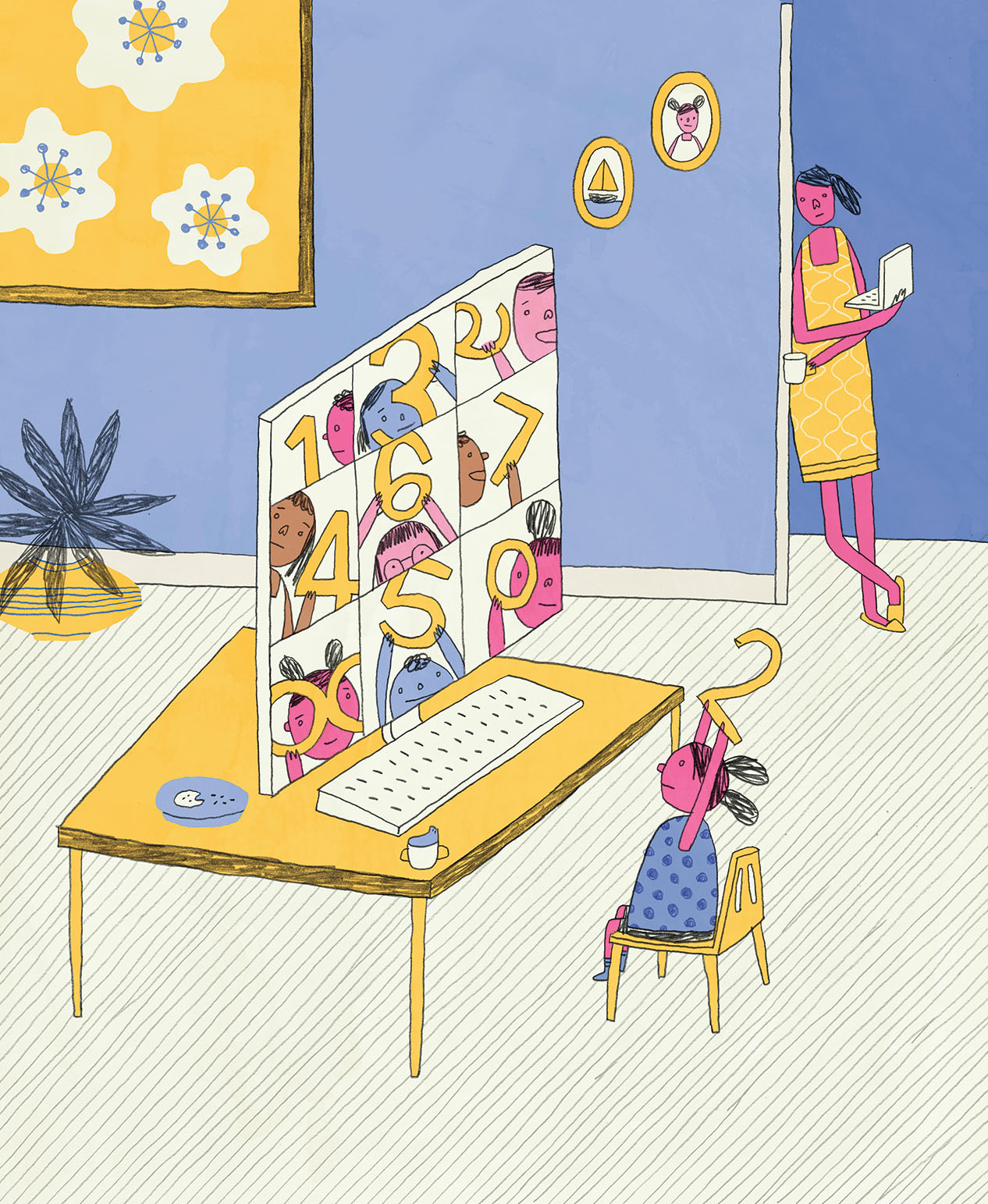
A Commitment to the Classroom
Lydia Krooss ’12 decided she wanted to become an elementary school teacher during her first week at Wellesley. She earned her teaching credentials in the teacher certification program run by the education department.
“My parents probably figured that 18-year-olds change their minds all the time, but I stuck with it,” she says. Today, Krooss remotely teaches third grade at a public school in Redwood City, Calif., outside San Francisco.
“It’s a very diverse suburb,” she says. The Redwood City district’s population is about 75 percent students who qualify for free or reduced lunch, and 75 percent Latino. “We have a lot of English learners and first-generation students, but then it’s also Silicon Valley, so we get lots of other [groups] mixed in there, too.”
This year, her third grade class has 25 students. “I feel like I am having the opposite experience from most of my friends in education right now, in that I feel like it’s going pretty, pretty well,” she says. “I don’t think you’re going to be able to replicate an in-person, all normal, no COVID situation. But I feel like they’re making good growth. They definitely feel like a class. They have friends, they have a collective identity, which is what I was worried about with the whole virtual thing.”
Internet access was an issue at first, Krooss says, but the school district provided Chromebooks to all the kids. “I know they were able to buy those with federal COVID money, and they got hot spots, too,” she says. “A lot of kids were given free hot spots. The first couple weeks it was a lot of, ‘This computer doesn’t work. This hot spot doesn’t work.’ But the district … did a very good job with that. And so now it’s only every once in a while you get the kids who are super-pixelated and we have no idea what they’re saying.”
Krooss says she misses seeing her students in person. “I miss the physical nature of the job. I miss doing projects. I have a huge library of books, and I miss passing around books and having kids actually read and touch them—the tactile part of school,” she says.
Even so, she’s not concerned that this will be a lost year for her third graders. “I think sometimes it’s simplified that kids from low socioeconomic backgrounds struggle the most, but I don’t know if it’s that cut and dried,” she says. “There are some kids who don’t have any privilege, really, at all, and are doing really well this year. They do well when they’re close with their siblings or close with their families, and they’re still doing well when they’re at home.”
For some children with social anxieties, remote school has been a boon, Krooss says. “When you take the school anxiety away, they’re able to actually focus on their schoolwork, and they feel confident. I’ve talked to families who say their kids were always really shy before, never speaking, but because it’s a computer, they feel open to speak and share in front of the room.”
Learning the Rules of Covid
Christina Kubota Ward ’90 has been teaching science and math at Norwood School, an independent school for pre-K through grade eight in Bethesda, Md., for five years. This year, she’s teaching science to pre-K, kindergarten, and third and fourth grade students—a total of about 120 children. So far, she sees most of them in person on campus.
“We started the year with just pre-K and K live, and we’ve added grades in a step fashion,” she says. “Everyone wears a mask, we do [COVID-19] testing every week, we have really high-grade filters in classrooms, and everyone is outside as much as possible. Snack is outside. Lunch is outside. We’re so fortunate, because even through November in DC, we’ve had very few blustery, awful days.”
Ward says the children are thriving. “My biggest surprise is how quickly the children have adapted to our new normal, which is wonderful to see,” she says. “But it’s also kind of sad, because you see little kids who are doing a great job with masks. It’s very rare that I have to remind them.”
Early in the year, Ward conducted an experiment to help convince her students about the importance of hand-washing. “I gave them a slice of apple, and I had them handle it with hands that had not been washed, and we tossed it in a plastic bag and labeled it. And then we had them use hand sanitizer, handle another apple, put that in the bag, and let it ‘cook’ for a few weeks. And they couldn’t believe how much nasty stuff grew on the first apple.”
Ward feels it’s important for children to learn the rules of COVID, to feel that there’s something in their environment that they can control. “So what can I control? Well, I can wear my mask, and I can make sure my hands are clean. And look at what happens. Look at the difference between the apple that had clean hands and the one from dirty hands!” she says.
The third rule of COVID safety, of course, is physical distancing. “They’re actually doing quite well with it,” Ward says. “If they forget, which they do because they’re kids, I’ve been surprised about how quickly they respond to, ‘OK, too close.’ And at Norwood, we’re the Blue Hawks, so we say, ‘OK, spread your wings!’ And they do. They spread their wings. They know how far to spread apart to stay safe.”

Showing Up
Juliet Kim Slotnick ’91has been teaching at Eliot Elementary School, a public school in Needham, Mass., for 12 years. This year, she’s working with a kindergarten class of 16. The district is following a hybrid model, with cohorts of students at school every other week.
“Last year, it was a nice, rich, developmentally appropriate curriculum, with a lot of hands-on activity, working in groups and with partners and sitting four kids at a table. This year, they’re at desks spaced 6 feet apart. All the rugs have been taken out of the room. It’s hard. But the children love being in school, in spite of the restrictions. But parents are saying their remote weeks are harder,” Slotnick says.
Things are hard for teachers, too. “I used to like Friday afternoons,” she says, “but now I usually stay late on Friday because it’s the switching of the cohorts, and it’s kindergarten, so I have to put all of their caddies away and take out the other group’s caddies and redo the desks, and sanitize everything. There’s just a lot of physical labor.”
Then there’s the preparation: “I plan for the kids who will be in front of me, and I also plan for the group at home. I set up all of those assignments and send out all the links, and I also meet with the remote group every day. So I’m running two classrooms simultaneously,” she says.
Despite the challenges, Slotnick just keeps showing up, as do the students. “More than any other year, they are so excited to be in school,” she says. “Nobody ever complains. They look forward to it every week. Nobody’s been out sick. It’s been perfect attendance almost every single day.”
With the approval of a vaccine, educators are beginning to hope there’s light at the end of the tunnel. A return to some degree of normal can’t come too soon for Slotnick. “I know why I’m doing this, and that’s not ever come into question,” she says. “But I do sometimes wonder how long I can keep doing it. As long as I’m focused on the immediate future, it’s fine. But when I think about the long term, I don’t know if I could do it for another year.”
Slotnick says she has never been so grateful for parents. “I tell my parents that I really appreciate them, because it’s not easy. They have to get the children on the Zoom calls, and they have to coordinate. They’re basically co-teachers in my classroom. It’s really all hands on deck at this time.”
Teaching Teachers
Alison Fox Mazzola ’93, an elementary education consultant based in San Bruno, Calif., works with teachers to sharpen their math instruction. “Teachers are saying they have never, ever worked harder. They are working 12 to 15 hours a day. Every seasoned teacher knows that first year is super hard. But then the second year is not quite as hard, and if you hit year five, you’ve got your shtick down. Everyone went back to being a first-year teacher in March.”
During the pandemic, Mazzola has been tutoring children one on one who aren’t thriving in the online environment. A former classroom teacher herself, she thinks the pandemic has put teachers in incredibly difficult positions—especially those with small kids of their own at home, or who have health challenges of their own or in their immediate families.
“I can’t even believe people are still teaching, honestly,” she says. “One school that I work with decided to open in person. They got waivers from the state, and they put in new ventilation. They spent almost $1 million getting the school ready to open in person—and when they announced they were going to open in person, six teachers quit.” Despite the challenges, Mazzola sees pandemic teaching as a way for teachers to learn new things. “I have been pushing the teachers I am working with to broaden their assessment lens,” she says. “Let’s not just look at, can this kid do two-digit plus two-digit addition? Let’s look at, can this kid persevere? When this problem is difficult, can they be resourceful? Can they find some ways to approach this problem? Can they make a sketch, draw some models to support themselves, rather than just can they get the right answer? What I really do hope this pandemic has brought is some more creative thinking about what we’re doing in schools.”
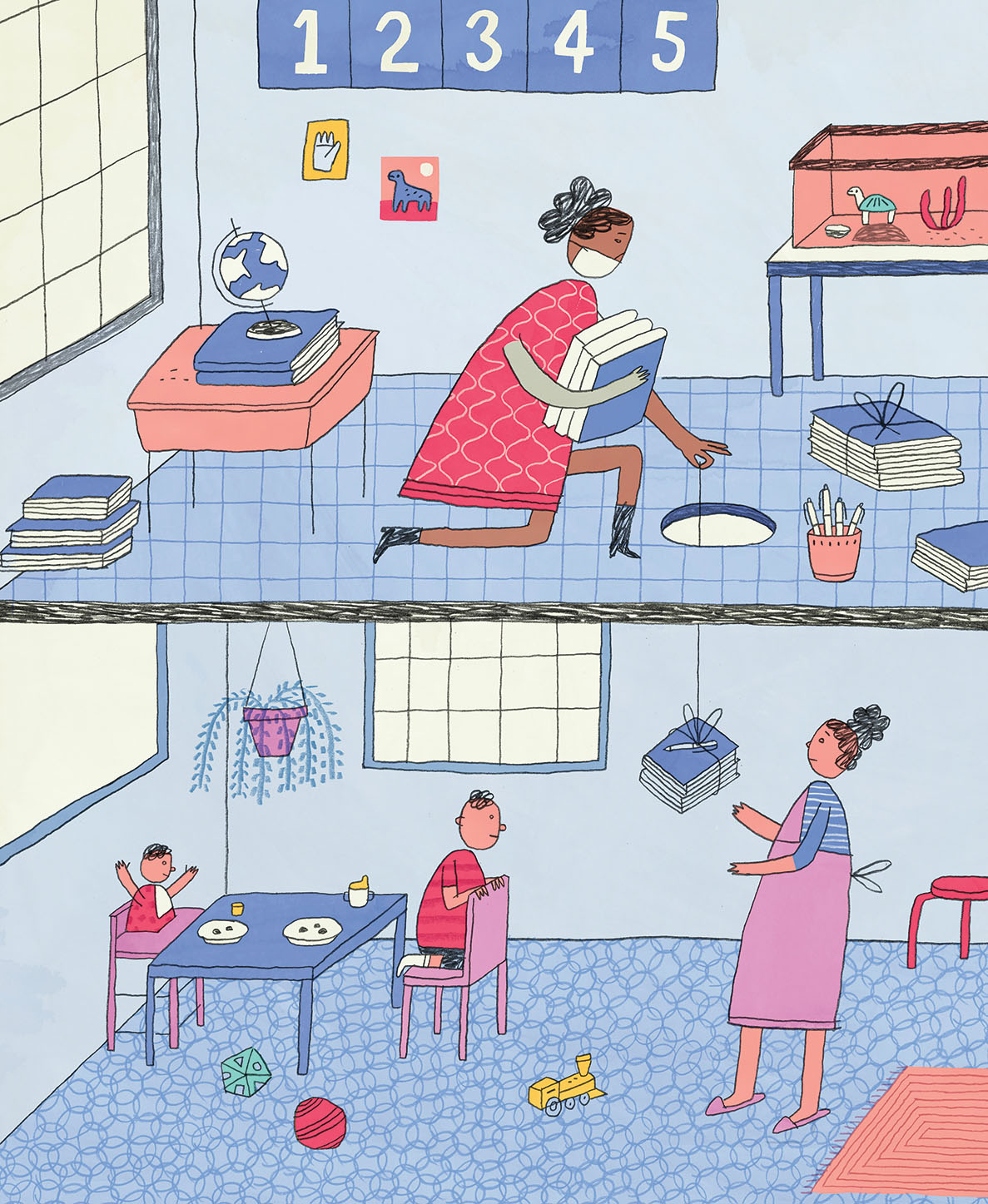
A Matter of Community
Amanda Vega-Mavec ’01 had just been promoted to director of the Academy for Children at El Centro, Inc., a preschool in Kansas City, Kan., when the COVID crisis hit. She very quickly found herself having to improvise.
“We’re in a minority-majority community,” says Vega-Mavec. “The vast majority of the residents are Latino, and the county we’re in also has a high African American population. A lot of our families are essential workers. People all around us were getting sick, and we didn’t know what was going to happen. How do we protect our community when our community is being hit incredibly hard?”
With infections skyrocketing, the decision was made to close down for a time. “We shifted to meeting the needs of the community, the families that weren’t working, or didn’t have food,” says Vega-Mavec. They took the groceries and supplies they had on hand and created food baskets for families. “We took everything we had in the building and portioned it out.”
They also created activity bags for their preschoolers. “It’s hard to put preschool kids on an iPad when so much of what we teach them is hands-on,” Vega-Mavec says. “And so we raided the building. Like many older schools, we had tons of things that had been accumulating. We pulled everything out of the closets and laid it out. We had tons of popsicle sticks—because what preschool doesn’t have a bajillion popsicle sticks lying around? We had crayons, we had stickers.” The teachers invented activities and put together kits. During the two months the building was closed, once a week they assembled food baskets and activity baskets for a drive-by pickup for the 40 or so families.
The situation has been deadly serious for the community Vega-Mavec serves. But she still finds things to laugh about.
This fall, the school reopened, with COVID-prevention procedures and enough supplies in place. “When I came on as the director right at the beginning of March, and I had to put in my first supplies order, I completely goofed up on the number of boxes of toilet paper,” Vega-Mavec recalls. “I remember the UPS guy coming in and he’s like, ‘What did you do?’ It was maybe two or three days later that the toilet paper shortage started. The big joke was, ‘Well, you have all the toilet paper!’ And eight months later, I still have not bought toilet paper again.”
‘We shifted to meeting the needs of the community, the families that weren’t working, or didn’t have food. We took everything we had in the building and portioned it out.’
Looking to the Future
At Capitol Hill Day School in Washington, D.C., early childhood teacher Jamayca Williams ’13 started the year outdoors. “For most of the fall, we did outdoor kindergarten, and it was fun. We had a lot of good times,” she says. As winter approached, the school followed a hybrid model, with some classes virtual and some indoors. After winter break, classes went fully virtual.
Online kindergarten has been great, but it took a lot of tweaks, Williams says. “The thing that I found that works the most is to make sure everybody has a lot of hands-on supplies. I send things home, and we do activities with those things virtually. They are learning. They are moving forward.”
Williams has created order for her kids with daily routines. “We end the day with a read-aloud. Then we always have our star for the day. That’s lifted us up and brought us a lot of joy. Then we sing our goodbye song and I blow out a candle.
“Kids are very resilient,” she adds. “They know what’s going on. They really get why we’re doing this, even though it’s not their ideal. They’re saying, ‘When coronavirus ends, I can give you a hug.’”
Catherine O’Neill Grace is a senior associate editor for this magazine, but she began her working life as a fourth and fifth grade teacher.
